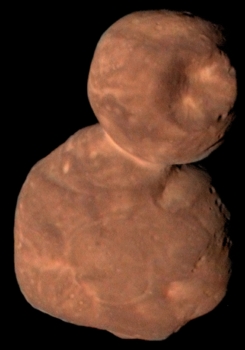
New Horizons was built by the Johns Hopkins Applied Physics Laboratotry.
Credit: NASA/Johns Hopkins University Applied Physics Laboratory/Southwest Research Institute/Steve Gribben/Alex Parker
OPEN LETTER ON HELIOPHYSICS INVESTIGATIONS FROM NEW HORIZONS
We are heliophysicists on or benefiting from data from the NASA New Horizons mission.
New Horizons has enabled uninterrupted heliophysics measurements throughout the heliosphere for over a decade, alongside its groundbreaking Kuiper Belt and other planetary observations. Three of its instruments have provided unique, essentially continuous, in-situ measurements of solar wind and interstellar pick-up ions, energetic particles, Galactic Cosmic Rays and dust. Additionally, New Horizons’ UV spectrograph is obtaining regular, unparalleled remote measurements of interplanetary hydrogen and all-sky mapping of the heliospheric boundary and nearby interstellar clouds.
The conduct of the mission’s heliophysics observations is both synoptic and in no way in competition with its planetary science observations of the Kuiper Belt and Kuiper Belt Objects.

Kuiper Belt Object (KBO) Arrokoth as viewed by New Horizons.
Image credit: NASA/Johns Hopkins APL/SwRI
In the coming years New Horizons can perform unparalleled planetary science and important astrophysical observations from its unique, distant position in the Kuiper Belt. And, over the next two decades of its expected operational lifetime, it can also carry out unprecedented, nearly-continuous heliophysics measurements during the traversal of the outer heliosphere out into the Very Local Interstellar Medium that Voyager could not make, offering insight into how the entire heliosphere is upheld.

The Interstellar Probe, a mission to provide a unified view of our heliosphere, out into nearby interstellar space.
Credit: Johns Hopkins/APL
Therefore, New Horizons continues to be a powerful cross-divisional tool that should continue to explore the heliosphere alongside its important studies of the Kuiper Belt, and to be a pathfinder scientifically, technically and even programmatically for future candidate missions such as an Interstellar Probe.
[Signed]
Pontus C. Brandt (JHU APL, Deputy Project Scientist)
Fran Bagenal (U Col, Heliophysics Science Theme Team Lead)
Andrew Poppe (UC Berkeley, Deputy Heliophysics Science Theme Team Lead)
Ralph McNutt (JHU APL, PEPSSI Instrument Lead)
Matthew E. Hill (JHU APL, NH Co-I and PEPSSI Instrument Scientist)
Heather Elliott (SWRI, SWAP Deputy Instrument Lead)
Mihaly Horanyi (U Col, Student Dust Counter, Instrument Lead)
Zoltan Sternosky (U Col, Student Dust Counter, Instrument Lead)
Randy Gladstone (SWRI, Alice Team Member)
Tracy Becker (SWRI, Deputy Alice Instrument Lead)
Merav Opher (Boston U., Co-I and SHIELD Director)
John Richardson (MIT, SHIELD Co-I)
Resources
For more information on the future of New Horizons, go to:
“Dream Machine: New Horizons, New Opportunities – Bad Politics?”
https://www.leonarddavid.com/dream-machine-new-horizons-new-opportunities/
Also, go to:
“Hard feelings over mission change for NASA’s Pluto spacecraft – US space agency plans to shift the New Horizons planetary probe to studying heliophysics, and some scientists don’t agree,” by Alexandra Witze/Nature
Go to: https://www.nature.com/articles/d41586-023-01530-y
Also, read these signature stories:
https://www.universetoday.com/160935/nasa-plans-threaten-new-horizons/


Some launch day photos on that link from Port Canaveral.
Bravo to the signees for dispelling any delusions that Team New Horizons is unable to better achieve the goals outlined in the Decadal Survey than any midstream team.
Let’s not kid ourselves.